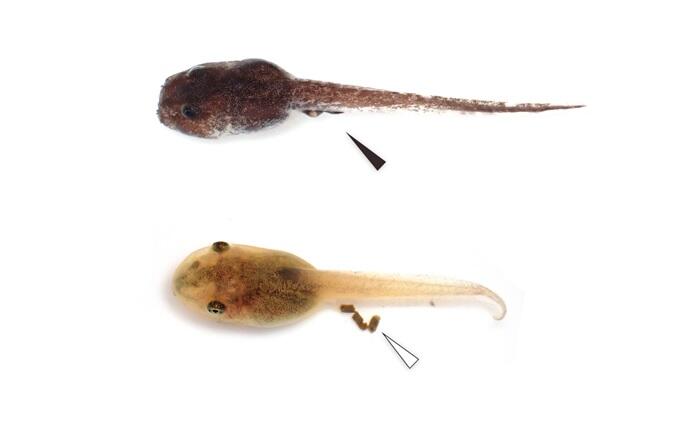Tadpoles of a certain frog species do not defecate during the whole larval period. A research group led by Special Research Student Bun Ito and Professor Yasukazu Okada of the Graduate School of Science at Nagoya University has discovered that tadpole larvae of Kurixalus eiffingeri, a frog inhabiting Ishigaki Island, Iriomote Island, and Taiwan, do not defecate during the whole larval period. The study was published in Ecology.

Photographed and provided by Bun Ito
Tadpoles (larvae) of K. eiffingeri grow up in small, isolated water pools, such as ones in tree hollows and bamboo stumps, where they rarely encounter natural enemies such as fish and crustaceans. This is the only frog in Japan that takes care of their offspring; the father protects the eggs from desiccation and natural enemies, and the mother feeds the larvae with unfertilized eggs laid by herself. The larvae feed exclusively on the unfertilized eggs laid by the mother until metamorphosis.
The larvae can survive in confined water pools where food is scarce, because the mother brings food from outside the water pool in the form of eggs; however, these pools also have a problem. This being that excretion contaminates the water environment and increases the concentration of ammonia. Larvae of common frogs die at higher rates when water in their living environment contains a higher level of ammonia. So, why does this not apply to K. eiffingeri?
The research group first focused on how much ammonia was discharged by the K. eiffingeri larvae into the environment. Larvae of K. eiffingeri and other frog species (Japanese tree frog Dryophytes japonicus, Japanese mountain brown frog Rana ornativentris, and Japanese forest green tree frog Zhangixalus arboreus) were reared in the same volume (20 milliliters) of distilled water, and changes in the ammonia concentration in the rearing water were measured over time. The results showed that K. eiffingeri larvae excreted a much smaller amount of ammonia into the environment than other species.
Next, the ammonia concentration in the gut contents, or feces, was measured. The results showed that the ammonia concentration in the larval gut was higher in K. eiffingeri than in other species. In other words, the larvae were found to retain feces containing large amounts of ammonia in the gut without passing it out of the body. Furthermore, the ammonia tolerance of K. eiffingeri larvae was examined.
The results showed that K. eiffingeri larvae rarely died even at an ammonia concentration at which Dryophytes japonicus could not survive (50 millimolar ammonium chloride). However, since K. eiffingeri larvae died at higher ammonia concentrations, the behavior of not defecating is considered advantageous to avoid increased ammonia levels in the environment.
These findings indicate that K. eiffingeri larvae are adapted to confined water pools through two strategies: reduced defecation and increased tolerance to ammonia in the environment. The species defecates for the first time just after metamorphosis to the subadult form (froglet stage). This indicates that nitrogen, brought into a small water body as food, is ultimately transported outside without being discharged into the water body. Such a sanitation strategy parallels the one used by some bees and ants, in which the larvae retain their feces in the gut until metamorphosis, keeping their narrow nests clean. The results suggest that growing up in a closed, confined environment with individuals of the same species, particularly with siblings, drives the evolution of unique sanitation strategies.
This article has been translated by JST with permission from The Science News Ltd. (https://sci-news.co.jp/). Unauthorized reproduction of the article and photographs is prohibited.




